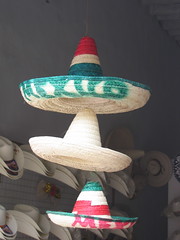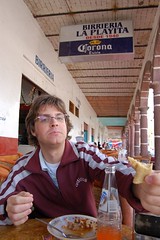A young Canadian traveler sadly
died outside of an Acapulco nightclub last week and news of his death is generating no shortage of headlines and emotionally charged comments on message boards. The facts are still sketchy, but similar to the case of the two Canadians killed in their Playa del Carmen hotel room last winter, the grieving family is alleging police and judicial ineptness. Many Canadians are also urging the federal government to issue a travel advisory for the entire country - instead of just certain zones like Oaxaca.
That would be overkill. Guadalajara is as tranquil as ever, as is
Chapala and Ajijic - where record numbers of
Canadians keep arriving each winter - and San Miguel de Allende. I spent the days leading up to New Year's in Mexico City with a Canadian friend and found it an ideal time to visit.
Canadians - even the ones that take winter junkets down to Puerto Vallarta and Cancun - really know very little about Mexico and thus a number of stupid and downright prejudiced comments have been appearing on message boards. These comments on the Globe and Mail's site by
someone called Lyn Alg tops them all for sheer ignorance:
"One would be safer and wiser to take a vacation in the centre of Baghdad or in Afghanistan than in Mexico."
Please. It's small town cheap comments like this that make me not miss Canada, which for all of its supposed tolerance and worldliness, is distressing parochial and small minded - not to mention ignorant of Latin America.
To its credit,
CTV posted a large collection of comments, which often struck a more reasonable note and included the feelings of Canadians presently residing in Mexico. One interesting theme was how many people had negative expriences in Acapulco. Those going to Puerto Vallarta grouse frequently about pushy time-share vendors, but those in the CTV forum raved about their experiences. Acapulco is badly over-built and ringed by slums. It's also in Guerrero, perhaps Mexico's most corrupt and backwards state. Acapulco is now a playground for rich
chilangos (Mexico City residents) and not a prime destination for foreigners.
Update: Mexican authorities attributed Adam DePrisco's death to a hit-and-run accident. The DePrisco family disagreed. Now an autopsy in Ontario confirms DePrisco was struck by a vehicle, but Adam's family said the results "don't add up."
The DePrisco family is also now charging Foreign Affairs Minister Peter MacKay and the Canadian government
with not doing more to help. Justice is unfortunately bad for Mexicans - not just foreign tourists. The government, in reality, can do little - and Canadians don't have a reputation of pushing for answers like their American counterparts.















